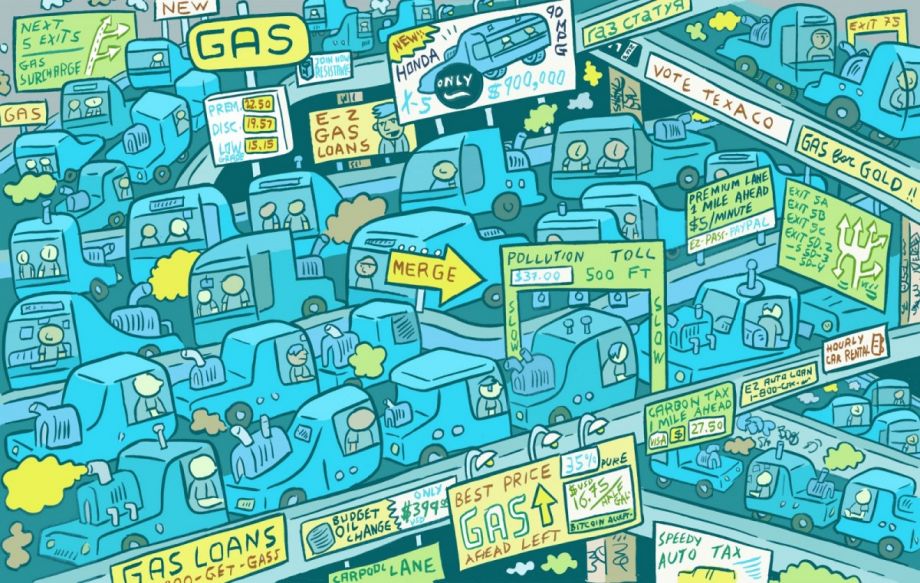From Cash to Controversy: Our Insider Look at Urban Infrastructure

(Illustration by Hawk Krall)
We published 51 longform features in 2014. And as regular Next City readers know, most of that excellent journalism (formerly branded as Forefront) was behind a paywall. Now that we’ve dropped that barrier, we want to highlight some stories you might have missed this year — or might want to share, now that everyone who cares about the future of cities can freely read.
This year, we covered everything from homelessness and pension reform politics to the role that mayoral spouses play in cities and the troubling uptick in female populations in U.S. prisons (in case you want to dig deeper than Orange Is the New Black).
However, some of our most popular pieces are about infrastructure — bike lanes, trains, pedestrian safety and more. We delve into the planning, funding, ambitions and, yes, controversy, swirling around these elements of urban life that directly affect all city-dwellers. (There’s plenty to cover, which is why we dedicate a daily column called the Works to the topic.)
So if you’d like to read, re-read or pass along some of our most important infrastructure stories from 2014, here are five places to start.
“The War on Cars Is Winnable”
Think more wealth means more car ownership means more headache-inducing traffic? Cities like Tokyo and Singapore have proven that with the right mix of smart policies and cultural shifts, a country can grow its GDP without consigning itself to a future of gridlock. In this story, Carlin Carr (yes, that’s her real name) looks ahead at the coming century and sees hope for the future of urban mobility.
Think more wealth means more car ownership means more headache-inducing traffic? Cities like Tokyo and Singapore have proven that with the right mix of smart policies and cultural shifts, a country can grow its GDP without consigning itself to a future of gridlock. In this story, Carlin Carr (yes, that’s her real name) looks ahead at the coming century and sees hope for the future of urban mobility.
“The Business of Bike-Share”
Big changes have recently arrived at Alta Bicycle Share; the bicycle share company was acquired by real estate giant REQX. Optimists say the move will improve the state of New York’s Citi Bike, but as bike-share booms across the U.S., funding of such programs is on the minds of cycling advocates everywhere. Zak Stone’s dig into Alta’s beginnings and its fast growth provides a critical window into the challenges of developing bike-share as a viable addition to the urban transportation ecosystem.
Big changes have recently arrived at Alta Bicycle Share; the bicycle share company was acquired by real estate giant REQX. Optimists say the move will improve the state of New York’s Citi Bike, but as bike-share booms across the U.S., funding of such programs is on the minds of cycling advocates everywhere. Zak Stone’s dig into Alta’s beginnings and its fast growth provides a critical window into the challenges of developing bike-share as a viable addition to the urban transportation ecosystem.
“The Port of the Future Is Arriving in Los Angeles”
Nate Berg explores Los Angeles’ vision of a sprawling oceanfront campus for marine research, education and green business incubation — a plan that could transform a hub of global commerce into a laboratory of sustainability, and offer a model for other cities asking what’s next for their ports.
Nate Berg explores Los Angeles’ vision of a sprawling oceanfront campus for marine research, education and green business incubation — a plan that could transform a hub of global commerce into a laboratory of sustainability, and offer a model for other cities asking what’s next for their ports.
“Why Streetcars Aren’t About Transit”
“Giddy” — that’s how the Washington Post recently described one D.C. spectator as he watched the first shiny, new car slide onto the rails of the capital city’s embattled streetcar line on H Street. He had been waiting a long time. Amid America’s modern streetcar revival, this feature delves into the implementation, the economic promise and the critics of this current transit trend.
“Giddy” — that’s how the Washington Post recently described one D.C. spectator as he watched the first shiny, new car slide onto the rails of the capital city’s embattled streetcar line on H Street. He had been waiting a long time. Amid America’s modern streetcar revival, this feature delves into the implementation, the economic promise and the critics of this current transit trend.
“New Orleans’ $6.2 Billion Water Problem”
As the fallout from Katrina made clear, the very infrastructure that modernized this city works against it when disaster strikes. That’s why local architects and advocates have put forth the Greater New Orleans Urban Water Plan. In this story, reporter Sarah Goodyear asks whether rain gardens, detention ponds, bioswales, porous pavement and the like represent the way forward for a perennially cash-strapped and tradition-bound New Orleans.
As the fallout from Katrina made clear, the very infrastructure that modernized this city works against it when disaster strikes. That’s why local architects and advocates have put forth the Greater New Orleans Urban Water Plan. In this story, reporter Sarah Goodyear asks whether rain gardens, detention ponds, bioswales, porous pavement and the like represent the way forward for a perennially cash-strapped and tradition-bound New Orleans.
The Works is made possible with the support of the Surdna Foundation.


No comments:
Post a Comment
Please leave a comment-- or suggestions, particularly of topics and places you'd like to see covered